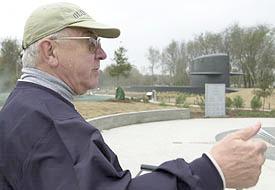| State of SC
Memorial Sites
Memorial Honors Cold War Submariners BY Bruce Smith [The Associated Press] Copied from The Salt Lake Tribune - Utah OnLine MOUNT PLEASANT, S.C. -- They went about their duties quietly, steadfastly and for the most part unnoticed, ready to fight a nuclear war that never came. Now a new memorial commemorates the thousands of submariners who, without firing a shot, helped the United States win the Cold War. "It's a tribute to the men who served and to their families who stayed home and to the people both in and out of the military who supported us," says retired Vice Adm. Albert Baciocco Jr., gazing toward the unusual memorial at the Patriots Point Naval and Maritime Museum.
The memorial sits on high ground depicting a submarine as it might have appeared sailing into Charleston Harbor. It even points in a compass direction of 299 degrees, the same heading subs would have followed at the harbor entrance. The 55-ton sail and fairwater planes from the decommissioned USS Lewis and Clark are set on a black stone base, the plantings around it giving the effect of the wake of a submarine. The rudder from the sub completes the memorial. The sail is the vertical tower atop a sub, while the planes are the wings on either side. Beyond the memorial, gray in the distance, is the aircraft carrier USS Yorktown and the verdigris waters of the harbor. Baciocco once commanded a submarine group in Charleston -- a group that included the USS Lewis and Clark -- and served as commander of the Charleston Navy Base, which closed in the mid-1990s. He headed a foundation that raised $1.2 million in donations and in-kind services over five years to build the memorial. The depiction of the submarine is enclosed by a gently winding path lined with smaller markers and stones memorializing other aspects of the Cold War. One notes the role of the British Navy, while another remembers the families of the submariners who waited at home while the vessels went out on their 70-day patrols. Still another stone memorializes the crews of two subs lost in accidents during the Cold War -- the USS Thresher in 1963 and the USS Scorpion in 1968. "Our submarines went to sea, a silent, invisible force solemnly dedicated to maintaining peace but ready to fight, if necessary, to defend our nation and our allies," reads the inscription on one marker. The recent memorial dedication was attended by retired Adm. James B. Osborn, who led the first ballistic missile sub patrol when the USS George Washington sailed out of Charleston in 1960. Former submariner Keith Schnebel of Summerville said the Charleston base of the United States Submarine Veterans plans to lead tours of the memorial. "It means a lot to us. ... This is a first of its kind," he said. The memorial commemorates the era between March 12, 1947, when President Harry S. Truman set forth the Truman Doctrine, and Nov. 9, 1989, when the Berlin Wall fell. The Cold War "was unique in history. Yet it was 40 years long and the world stood on tenterhooks so to speak," Baciocco says. "At the same time, we had these kids at SAC [Strategic Air Command] who were on alert on the ground or alert in the air flying over Alaska all the time," he says. "Then we had these kids sitting in holes out in North Dakota with the Peacekeeper missile and all. That was all part of it." The work was largely unheralded. "Do they get a medal? Do they get recognized by the people in town who say what a great hero you are? No. [But] the heroism and the dedication was something else," Baciocco says. "That's why I thought this was important." For more information: call the Patriots Point Naval and Maritime Museum at 843-884-2727 or visit http://www.state.sc.us/patpt/ The Web site of the Cold War Submarine Memorial is http://www. cwsmf.org |
